Philips 276E6 27-inch Quantum Dot Monitor Review
We've been hearing about Quantum Dots for a while but Philips' 276E6 is the first computer monitor to use the technology. It's a 27-inch IPS-ADS screen with FHD resolution and an Adobe RGB color gamut. Today, we check it out in our labs.
Why you can trust Tom's Hardware
Grayscale Tracking And Gamma Response
Our grayscale and gamma tests are described in detail here.
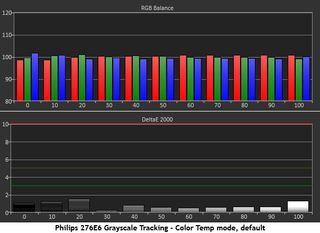
The Color Temp mode is nearly perfect out of the box on its 6500K preset. The only rub is you can't adjust Brightness without switching the 276E6 into its Adobe RGB mode, which does require adjustment. As long as you're OK with the bright 370cd/m2 output, Color Temp is the way to go.
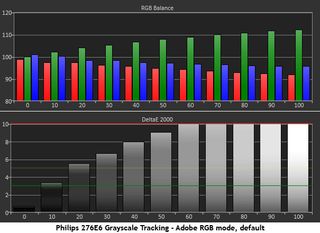
Here's what we mean when we say "too green." Without some adjustment, the Adobe RGB mode looks pale and flat with an obvious tint to brightness levels above 10 percent. Even with the expanded color gamut in play, images don't look their best here.
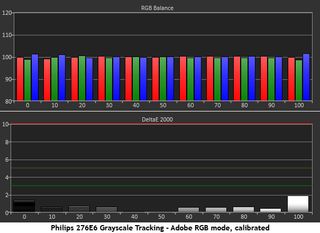
Calibrating the Adobe RGB mode produces the best possible performance. The 276E6 matches any professional screen in the quality of its grayscale tracking. You can thank its precise RGB sliders with 100-step resolution for this excellent chart.
Here is our comparison group.
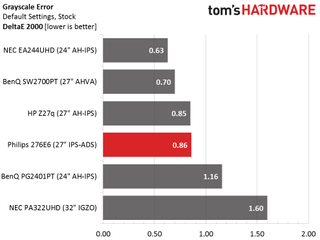
You can see that the Color Temp mode has no real flaw and is perfectly usable. This is a great out-of-box result. Our only complaint is the locked-out Brightness control.
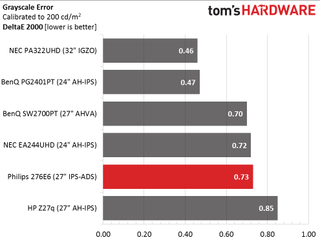
Though calibration is required in the Adobe RGB mode, it only yields a small improvement over Color Temp. But that is the price for having control over brightness, which is fairly important in our opinion.
Gamma Response
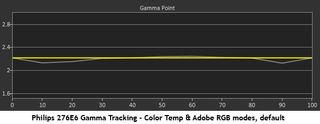
In the default states of both the Color Temp and Adobe RGB modes, gamma tracking is quite good with only tiny dips at the 10 and 90 percent levels. You'll see later how this has a positive effect on color balance.
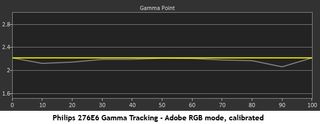
Calibration leaves gamma tracking largely unchanged. The average value has dropped slightly but we can't see a difference in real-world content. If your tastes run to a darker or lighter presentation, there are five total presets ranging from 1.6 to 2.8.
Here is our comparison group again.
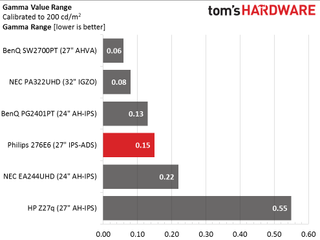
.15 is a fairly tight range of values and lands the 276E6 mid-pack among these high-end displays. We're glad to see that Philips has adhered to accepted standards here as they showcase their new technology.
We calculate gamma deviation by simply expressing the difference from 2.2 as a percentage.
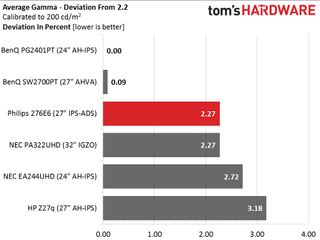
With a 2.15 average value, gamma runs a tad light but again, it's not something you'll be able to discern in normal use.
Current page: Grayscale Tracking And Gamma Response
Prev Page Brightness And Contrast Next Page Color Gamut And PerformanceStay on the Cutting Edge
Join the experts who read Tom's Hardware for the inside track on enthusiast PC tech news — and have for over 25 years. We'll send breaking news and in-depth reviews of CPUs, GPUs, AI, maker hardware and more straight to your inbox.

Christian Eberle is a Contributing Editor for Tom's Hardware US. He's a veteran reviewer of A/V equipment, specializing in monitors. Christian began his obsession with tech when he built his first PC in 1991, a 286 running DOS 3.0 at a blazing 12MHz. In 2006, he undertook training from the Imaging Science Foundation in video calibration and testing and thus started a passion for precise imaging that persists to this day. He is also a professional musician with a degree from the New England Conservatory as a classical bassoonist which he used to good effect as a performer with the West Point Army Band from 1987 to 2013. He enjoys watching movies and listening to high-end audio in his custom-built home theater and can be seen riding trails near his home on a race-ready ICE VTX recumbent trike. Christian enjoys the endless summer in Florida where he lives with his wife and Chihuahua and plays with orchestras around the state.

Corsair's Elite 6500 ATX and Elite 2500 Micro-ATX get accent panel options — removable panels available in wood and aluminum

Alleged Zen 5 'Strix Halo' Mobile APU has more GPU cores than RX 7600 XT or PS5 — features monster RDNA 3.5 GPU with 40 compute units

Grab this cool retro console inspired keyboard for just $83
-
xenol Finally! I've been really wanting to see this technology come through to more than two products (that I'm aware of)Reply -
Dan414 I'm not too concerned with power consumption at my desk. How about phones and laptops - will we see quantum dot screens there soon?Reply -
gunbust3r Takes some design ability to make a 27" look more like a 22", good job on those monster size white bezels. :pReply -
sillynilly Love the tech, but the screen specs at that size will make it look like monster dot technology. 1920 x 1080 at 27" looks just horrendous after using a higher rez monitor. Some monitor OEMs are a bit behind the times it seems (although this tech is pretty cool).Reply -
picture_perfect ReplyFor gamers seeking vivid color and a bright image, your monitor has arrived. 18ms is an excellent score for any 60Hz display
I can only LOL and I never LOL. 18ms response (57ms total lag) is just god awful terrible. These arbitrary endorsements are getting lame. -
CaedenV Did I miss where it has a price? It can be the best consumer display in the world, but if it is $5,000 then that would not make it a recommended buy.Reply -
Nintendork All this quantum bull* and still 1000:1? Meanwhile tablets and smartphones using IPS neo from jdi with near 2000:1.Reply
Or even better an RGB OLED display.